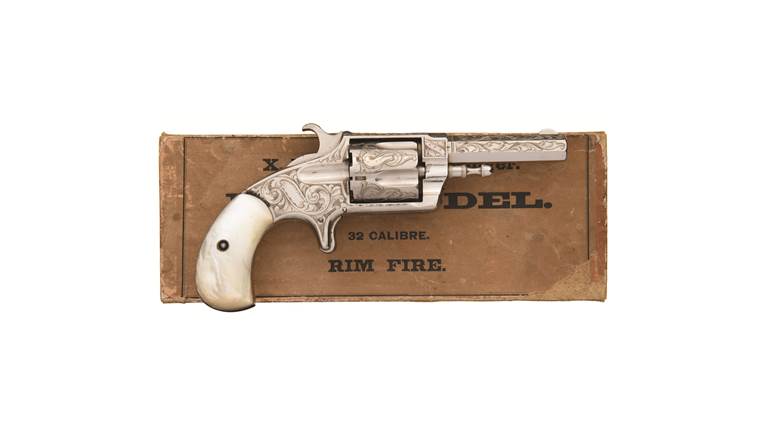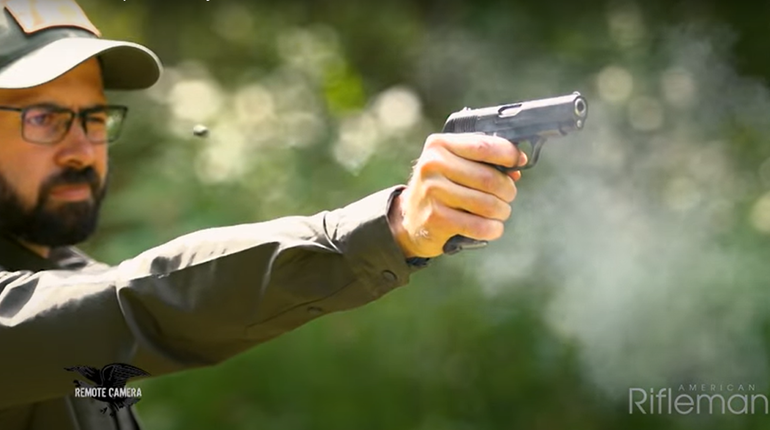
Top image: Japanese troops land in Korea carrying Type 30 Arisaka rifles.
The Russo-Japanese war of 1904-1905 is one of those rarely discussed conflicts that provides an important preview to important developments in warfare and weapons technology. Only the most astute observers seem to realize what is happening on these less publicized battlefields. The new weapons and tactics of the Russo-Japanese War would soon present themselves in August 1914, with the opening moves of World War I.
As the rising Japanese Empire went to war with the Czar’s fading imperial light, most Americans favored isolationism. Little attention was paid to the violence in the Northwest Pacific, until President Teddy Roosevelt acted as mediator for the end of hostilities. Roosevelt brokered the Treaty of Portsmouth on Sept. 5, 1905.
Japanese troops in transit in Manchuria. Type 30 Arisaka rifles are stacked in the foreground.
One of the defining battles of the war was the Siege of Port Arthur, the extensive Russian naval base on the Liaodong Peninsula in Manchuria. Port Arthur was the symbol of Russian dominance in the region, and the region was one of the most heavily fortified areas of the world—housing 50,000 Russian troops and more than 500 artillery pieces. Major-General Baron Anatoly Stoessel was in command. To take Port Arthur the Japanese committed their Third Army, totaling almost 150,000 men (supported by almost 500 artillery pieces), and led by General Baron Nogi Maresuke. By August 1, 1904 the battle lines had been drawn.
Japanese infantry leaving Tokyo for duty in the Russo-Japanese War. A Type 30 carbine is visible inside the train car.
A New Generation of Samurai
The Russians had improved the old Chinese defenses at Port Arthur, developing an extensive network of forts and trench lines in the series of hills that surrounded the approaches to the city. Even though many of the fortifications were still being finished when war broke out, Japanese planners seriously underestimated the Russian defenses. The Japanese countered with a rapidly modernized army whose soldiers were still instilled with the ancient spirit of “Bushido.” Japanese forces outnumbered the Russians three to one at Port Arthur, but it was the spirit of the sons of the Rising Sun that allowed Japanese forces to absorb tremendous losses and yet continue their attacks.
British Lieutenant General Sir Ian Hamilton K.C.B. was an observer embedded with Japanese forces throughout the war, and commented on the state of the Japanese troops in his book “A Staff Officer’s Scrapbook During the Russo-Japanese War” (published in 1907): “All the soldiers here look pale and tired. Their knapsacks had been left behind when they started on the night of the 25th to make their night attack, and their thin khaki is soaked and clinging clammily to their limbs. Nevertheless, they manage to be cheerful whilst making their morning toilette by the banks of the muddy streamlet. Many of them are wounded, but none the less happy on that account unless they suspect that the doctor many take too serious a view of such a trifle as a bayonet wound in the eye or a bullet through the foot, and put them temporarily on the shelf For the tenth time at least I must write down that the Japanese infantry consist of superb material. Guileless as children, brave as lions, their constant ruling thought is to do their duty by their ancestors and by the Emperor.”
Arms for a New Century
The battles at Port Arthur saw the introduction of a great deal of military technology for a new century of warfare. In addition to the modern small arms in the hands of the infantry, many elements that would soon be seen on the battlefields of World War I were present in the Russo-Japanese War: modern siege howitzers capable of quickly demolishing old-style fortifications; light field guns that could move quickly with assaulting infantry; and modernized trenches with barbed wire, electrified fences, searchlights and telephone systems for the defenders.
Russian troops with Maxim machine guns await the Japanese advance.
The Imperial Russian Army had acquired 58 Maxim machine guns during 1899 and these impressed the Czar’s military advisors enough that they purchased a license to manufacture the machine gun. However, the Russians didn’t begin to manufacture the Maxim at home until 1910. After the war with Japan started, Russia quickly acquired more than 400 Maxim guns from multiple international suppliers. The Maxim Gun is the grandfather of all heavy machine guns, water-cooled and extremely reliable. The Russian Maxims hammered out 600 7.62x54 mmR rounds per minute, felling many a modern samurai in their repeated human wave assaults on Port Arthur defenses.
Russian troops assemble at Mukden: the Russian infantry doctrine was to keep the socket bayonet affixed to the rifle at nearly all times.
After their experience in China, using machine guns for the first time during the Boxer Rebellion, Japan acquired a license to produce the French Hotchkiss M1897 machine gun. By the beginning of the Russo-Japanese War, each of the Emperor’s divisions had 24 Japanese-made Hotchkiss M1897 machine guns, chambered in 6.5x50 mm Arisaka. At Port Arthur the Japanese made limited use of their MGs in the assault as their weight proved prohibitive for the attacking troops (each air-cooled Hotchkiss MG weighed 52 lbs. without its tripod). Even so, the Russo-Japanese War heard the frequent chatter of machine guns on both sides of the lines for the first time in history.
In the battleground of Port Arthur, the poor, miserable infantry were, at least, equipped with modern rifles. Russia had recently begun to replace their Model 1870 Berdan II rifles (“Berdana” in Russian) with the Mosin-Nagant M1891 rifle. Deliveries of the Mosin-Nagant (chambered in 7.62x54 mmR) started slowly but kept building over the years. The last time anyone checked, more than 37 million have been made and continue to be used on battlefields that range from Syria to the Ukraine.
Port Arthur defenders: Russian riflemen armed with the M1891 Mosin-Nagant rifle.
In 1904 the potent capabilities of the new Mosin rifles and their high-velocity ammunition (2,838 f.p.s.) allowed Russian riflemen to engage targets out to nearly 500 yards—not that the average Russian soldier could make shots at that range, but it was clear that the danger zone of new century battlefields had increased dramatically. The Mosin rifle uses a five-round (non-detachable) magazine that can be loaded with five-round stripper clips or individual rounds. It’s a thin, elegant rifle, 48½" long and awkwardly long with its 19½" bayonet attached. No scabbard was provided, as Russian doctrine dictated that the bayonet should remain on the rifle at all times. Accordingly, most photos of the M1891 rifle from this era show the socket bayonet attached. Similarly, photos of Russian troops in the Port Arthur area show them to be armed with the modern Mosin-Nagant rifle, although it is quite likely that second-line troops retained the older Model 1870 Berdan II single-shot rifles.
Firing line in Manchuria: Japanese troops armed with the older Type 22 Murata rifle (8x53R Murata).
The Japanese had quickly modernized their forces during the last two decades of the 19th century. Beginning in 1880, Japan adopted its first indigenously designed and produced rifle using smokeless powder—the Type 13 (designated for the 13th year of Emperor Meiji's reign), an 11 mm, single-shot, bolt-action rifle. The Type 13, Type 18 and Type 22 Murata rifle had served the Imperial Japanese Army during their war in China during 1894–1895, as well as in the Peking Relief Expedition of 1900. Various technical issues led the Japanese to replace the Murata rifle with the much more modern Arisaka Type 30, designed in 1898.
Japanese troops in action with Type 30 Arisaka rifles.
By 1904, most Japanese troops carried either the Arisaka Type 30 rifle or the Type 30 carbine. Both were chambered in 6.5x50 mm Arisaka. The Type 30 was reliable and accurate enough, even though its sights were calibrated out to 2,200 yards. Throughout the Russo-Japanese War, the Emperor’s infantrymen proved themselves the equal of their Russian counterparts. Demand for the Type 30 outstripped availability, and in 1905 some Japanese units deployed to Manchuria with the Type 22 Murata rifle. In a strange twist, the Russians purchased thousands of Type 30 rifles from Japan to make up for the shortage of M1891 Mosin-Nagant rifles during World War I.
The surrender: On Jan. 5, 1905 the Russians surrendered Port Arthur, with more than 20,000 men going into prisoner-of-war camps. Russian Generals Stoessel, Foch and Smirnov were court-martialed upon their return to St. Petersburg.
A Stark Preview of World War I
The cost of the siege of Port Arthur was staggering by modern standards, and the casualties provided a stark preview of the slaughter coming during World War I. Russian forces suffered 31,306 casualties, with more than 6,000 killed. More than 24,000 Russians became prisoners of war. The Japanese admitted to 57,780 casualties, at least 14,000 of them killed. Historians suspect that the real casualty numbers for both sides were higher. Regardless, the point was made, but not necessarily learned: 19th century tactics coupled with 20th century weapons guaranteed death on a massive scale.




































